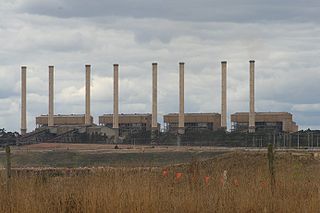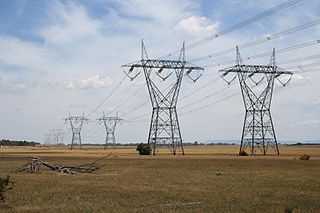The National Electricity Market (NEM) is an arrangement in Australia's electricity sector for the connection of the electricity transmission grids of the eastern and southern Australia states and territories to create a cross-state wholesale electricity market. The Australian Energy Market Commission develops and maintains the Australian National Electricity Rules (NER), which have the force of law in the states and territories participating in NEM. The Rules are enforced by the Australian Energy Regulator. The day-to-day management of NEM is performed by the Australian Energy Market Operator.

EnergyAustralia was a state–owned enterprise of the Government of New South Wales, Australia. It was electricity and gas supplier and retailer which primarily supplied the Sydney, Newcastle and Central Coast areas of New South Wales. after market deregulation, it increased its focus on retail supply opportunities in electricity and gas to the Victorian market and electricity in the deregulated South East Queensland.

The Hazelwood Power Station was a decommissioned brown coal-fuelled thermal power station located in the Latrobe Valley of Victoria, Australia. Built between 1964 and 1971, the 1,600-megawatt-capacity power station was made up of eight 200MW units, and supplied up to 25% of Victoria's base load electricity and more than 5% of Australia's total electricity demand. It was a 'subcritical' pulverized coal-fired boiler. The station was listed as the least carbon efficient power station in the OECD in a 2005 report by WWF Australia, making it one of the most polluting power stations in the world. At 1.56 tonnes of CO2 for each megawatt hour of electricity, it was 50% more polluting than the average black coal power station in New South Wales or Queensland. Hazelwood emitted 14% of Victoria's annual greenhouse gas emissions and 3% of Australia's greenhouse gas emissions.
Public electricity suppliers (PES) were the fourteen electricity companies created in Great Britain when the electricity market in the United Kingdom was privatised following the Electricity Act 1989. The Utilities Act 2000 subsequently split these companies between distribution network operators and separate supply companies.
EnergyAustralia is an electricity generation, electricity and gas retailing private company in Australia. It is one of the "big three" retailers in the National Electricity Market. It generates electricity primarily using coal fired generation, at the Yallourn Power Station in Victoria, and the Mount Piper Power Station in New South Wales. 10% of its generation is from wind power, 32% from gas, and 58% from coal. It is Australia's second biggest emitter of greenhouse gases, after AGL Energy. As a loss making company in 2023, its parent in Hong Kong, CLP Group, has stated that it is looking for partners for renewable energy investment, however as of this time, there were no plans to build new renewable energy itself.

Country Energy, an Australian energy retail subsidiary of Origin Energy, provides natural gas and electricity to retail customers in New South Wales, Victoria, Queensland, South Australia and the Australian Capital Territory.. Since its establishment in 2001 and until 28 February 2011, Country Energy was owned by the Government of New South Wales.

Energex is an Australian-based wholly Queensland Government owned electricity company distributing power to 1.5 million homes and businesses in South East Queensland. The boundaries of the company’s distribution area stretch from Coolangatta in the south to Gympie in the north and as far west as the foothills of the Toowoomba range.
Alinta Limited was an Australian energy infrastructure company. It has grown from a small, Western Australia-based gas distributor and retailer to the largest energy infrastructure company in Australia. It was bought in 2007 by a consortium including Singapore Power and various parties which include the now defunct Babcock & Brown funds.
SWALEC was an electricity supply and distribution company in South Wales, established in 1989 following the de-regulation of the electricity supply industry in the United Kingdom. The business has seen several changes of ownership from 1996, and the SWALEC brand has been used for retail gas supply as well as electricity. Today National Grid runs the distribution network business, and SWALEC Contracting is a trading name of OVO Energy. The name SWALEC is a syllabic acronym of 'South Wales Electricity'.

AGL Energy Ltd is an Australian listed public company involved in both the generation and retailing of electricity and gas for residential and commercial use. AGL is Australia's largest electricity generator, and the nation's largest carbon emitter. In 2022, 83% of its energy came from burning coal.

Renewable energy in Australia is mainly based on biomass, solar, wind, and hydro generation. Over a third of electricity is generated from renewables, and is increasing, with a target to phase out coal power before 2040. Wind energy and rooftop solar have particularly grown since 2010. The growth has been stimulated by government energy policy in order to limit the rate of climate change in Australia that has been brought about by the use of fossil fuels. Pros and cons of various types of renewable energy are being investigated, and more recently there have been trials of green hydrogen and wave power.

Energy in Victoria, Australia is generated using a number of fuels or technologies, including coal, natural gas and renewable energy sources. Brown coal, historically, was the main primary energy source for the generation of electricity in the state, accounting for about 85% of electricity generation in 2008. The amount of coal-fired power has decreased significantly with the closure in 2017 of the Hazelwood power station which supplied around 20% of Victoria's electricity, and to a lesser extent with the exit of Anglesea power station in 2015. Brown coal is one of the largest contributors to Australia's total domestic greenhouse gas emissions and a source of controversy for the country. Australia is one of the highest polluters of greenhouse gas per capita in the world.

Engie SA is a French multinational utility company, with its headquarters in La Défense, Courbevoie, which operates in the fields of electricity generation and distribution, natural gas, nuclear, renewable energy and petroleum. It is active in both upstream and downstream activities.

SGSP (Australia) Assets Pty Ltd (SGSPAA), trading as Jemena, is an Australian company that owns, manages or operates energy infrastructure assets in the eastern states of Australia including Queensland and New South Wales, and gas pipelines and gas and electricity distribution networks in Victoria and the Northern Territory. It is 60% owned by State Grid Corporation of China and 40% by Singapore Power.
The Australian Energy Market Operator (AEMO) performs an array of gas and electricity market, operational, development and planning functions. It manages the National Electricity Market (NEM), the Wholesale Electricity Market (WA) (WEM) and the Victorian gas transmission network. AEMO also facilitates electricity and gas full retail contestability, overseeing these retail markets in eastern and southern Australia. It is additionally responsible for national transmission planning for electricity and the establishment of a Short Term Trading Market (STTM) for gas.

Lumo Energy is an Australian energy retailer operating in Victoria and South Australia, which has been wholly owned by Snowy Hydro since 2014. The business offers electricity and gas packages in Victoria and South Australia. As of October 2017, the business had almost 500,000 customers and a workforce of just under 500 people.
Alinta Energy is an Australian electricity generating and gas retailing private company owned by Hong Kong-based Chow Tai Fook Enterprises (CTFE). The sale for $4 billion was approved by Treasurer Scott Morrison in 2017. Alinta Energy has an owned and contracted generation portfolio of up to 1,957 MW, approximately 1.1 million combined electricity and gas retail customers and around 800 employees across Australia and New Zealand.

Click Energy is an Australian energy retailer selling electricity to private and business customers in Victoria, New South Wales, South Australia and Queensland.
Octopus Energy Group is a British renewable energy group specialising in sustainable energy. It was founded in 2015 with the backing of British fund management company Octopus Group, a British asset management company. Headquartered in London, the company has operations in the United Kingdom, France, Germany, Italy, Spain, Australia, Japan, New Zealand and the United States. Octopus is the UK's largest supplier of electricity to domestic customers, and the second largest in domestic gas.
Shell Energy Australia provides gas, electricity, environmental products and energy productivity services to commercial and industrial customers.











